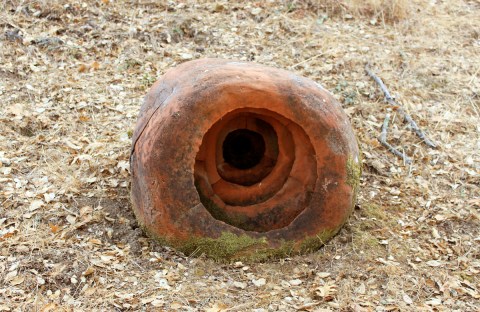Goldsworthy’s Clay Works for Runnymede
These are my photos of the Andy Goldsworthy piece at Runnymede. I kept them separate from the last post in part because I didn’t want a single post with 35 photos, but also because his work really does contrast with the rest of the sculptures on the property. He is the only land artist in the collection, and his is the only work that was designed and built onsite with materials from the site; he and the Runnymede staff made the clay with soil dug from the side of the road there at Runnymede, and then they used that excavation, resembling a slump in the road cut, as part of the piece. Also, his is the piece most clearly about negative space, not just the negative space inside the pots but also the negative space of the land itself; all of the other sculptures are essentially an object placed on the land, but his takes your eye down inside that land. And his is the only one that is really a sequence: you see the first pot and then another and another, and it builds into a little narrative as you walk along the trail. In some ways, I think the Runnymede collection as whole does this — your landscape experience builds out of what you’ve seen and your anticipation for what the next sculpture will be — but the Goldsworthy work does this on its own.
It was interesting to stand there, discussing it and observing people’s reactions. Most people liked it; some folks were not sure what to think of it, finding it perhaps overly subtle; a majority of them had heard of Goldsworthy and many were there specifically to see his piece, but fewer had seen Rivers and Tides than I expected. A few people power-walked past without even noticing it was there.
I’m not sure if you are supposed to see it from the bottom or the top, but there’s a clear evolution throughout the sequence whichever end you start at. The lower pots are more cracked and they sit more clearly perched on top of the land; the upper pots are more intact and more deeply embedded, culminating with the final pot sunk into the ground at the source of the clay. There’s an argument for starting at the top and walking along as the pots emerge and become more fragmented, perhaps an illustration of time or entropy; personally, I liked the sequence from the bottom, seeing the pots gradually take your focus into the earth, back to their origin, so that’s the order I’m showing. The entire sequence is below.
Tags: clay, Goldsworthy
This entry was posted on Sunday, September 30th, 2012 at 5:50 am and is filed under sculpture. You can follow any responses to this entry through the RSS 2.0 feed. You can leave a response, or trackback from your own site.

















October 1st, 2012 at 8:24 pm
So cool. I didn’t know this piece until now. I like how the piece really is “land art” in its most primal form, like you point out, how it focuses you on how the piece comes out of the land and might be in the slow process of returning to it. I enjoy the patina that old clay pots take on. Nice to see this piece going the same direction. Thanks for the tour.
October 5th, 2012 at 4:01 pm
Right, I hadn’t seen it either. It’s from 93-94, so it’s almost 20 years old.